|
||||||||||||||||||||||||||
|
||||||||||||||||||||||||||
|
|
||||||||||||||||||||||||||
|
||||||||||||||||||||||||||
|
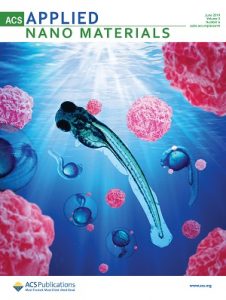
In research carried out in a number of Brazilian laboratories, a multidisciplinary scientific team developed a magnetic, luminescent nanomaterial capable of chemically binding to molecules of interest, such as drugs or proteins. This nanomaterial also showed low toxicity in tests with living organisms. With this set of characteristics, the new material can be seen as a multifunctional nanoplatform that is promising for the development of various applications, especially in the areas of biotechnology, health and environment. The study was reported in an article published in ACS Applied Nano Materials (American Chemical Society journal released in 2018), and featured on the cover of the June issue of the journal.
The properties of this nanoplatform derive from the presence of several compounds and elements with distinct properties: iron oxide (Fe3O4, known as magnetite) nanoparticles responsible for magnetism; lanthanide element ions (Gd3 +, Ce3 + and Tb3 +, known as rare earths) responsible for luminescence or light emission, and chitosan (biopolymer obtained from the crustacean exoskeleton), essential for providing chemical bonds of the nanoplatform surface to the external molecules of interest.
The nanoplatform was developed at the Brazilian National Nanotechnology Laboratory of the National Center for Energy and Materials Research (LNNano – CNPEM). The process used for its synthesis comprises a series of steps. Initially, the iron oxide nanoparticles that form the core of the nanoplatforms are synthesized and coated with silicon dioxide (SiO2). Then the luminescent elements and chitosan are incorporated into the nanoparticles forming an outer layer. The result is nanoplatforms of approximately 170 nm in diameter (on average), called Fe3O4@SiO2/GdOF:xCe3+,yTb3+.
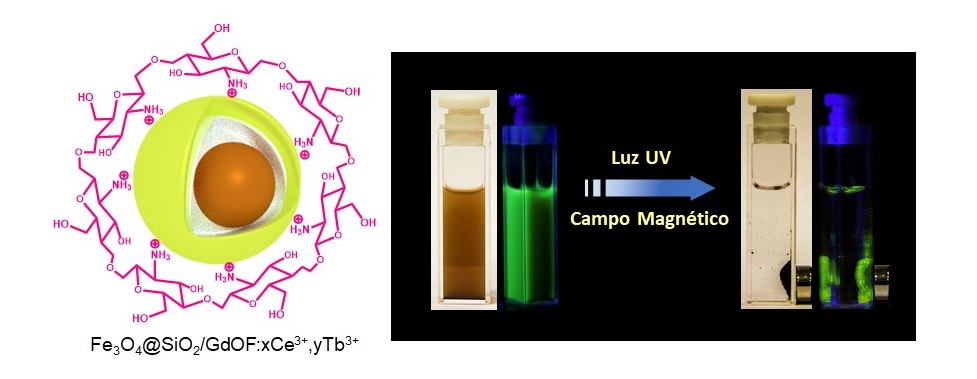
To study the magnetic and luminescent properties of the nanoplatform and to characterize its structure and morphology, research groups from the State University of Campinas (Unicamp) and the University of São Paulo (USP) participated in the study.
In addition, the main authors of the paper decided to evaluate the toxicity of nanoplatforms with relation to living organisms – a key step when thinking about health or environmental applications, and they decided to conduct a well-established in vivo test, in which zebrafish embryos (scientific name Danio rerio) are exposed to the material whose toxicity is to be evaluated. These freshwater fish, in fact, has a high genetic similarity to humans (about 70%) and at the same time is cheaper and easier to study than mice or rats, among other advantages.
In the toxicity test, a few dozen freshly fertilized zebrafish eggs were placed in aqueous medium containing the nanoplatforms at various concentrations. The embryos were examined at different development stages using an optical microscope to check for mortality, malformation, edema or changes in size. Tests included embryos with and without chorion (membrane that protects the embryo in the early stages of development). The test results carried out at LNNano showed that nanoplatforms, even at high concentrations (100 mg/L), have low toxicity for all embryo groups.
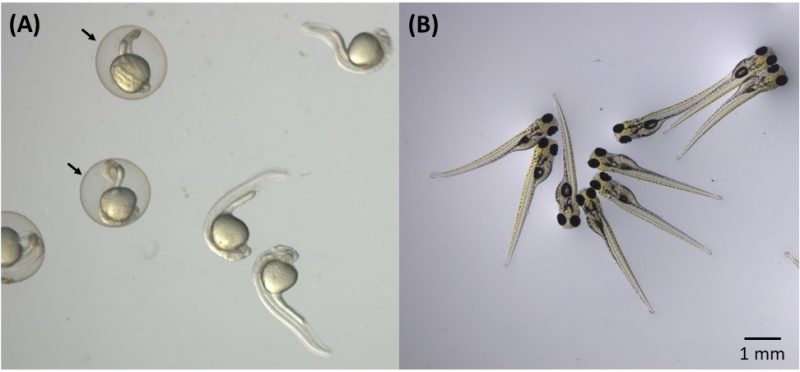
“This work brings an unprecedented contribution that involves evaluating the toxicity of hybrid nanomaterials using the zebrafish model, a promising alternative method in nanotoxicology, and the influence of the chorion,” says Diego Stéfani Teodoro Martinez, CNPEM researcher at LNNano and one of the corresponding authors of the article.
The embryos were also analyzed at the Brazilian National Synchrotron Light Laboratory (LNLS – CNPEM) to verify the distribution and concentration of nanoplatforms in the organism of the embryos. To do this, the scientists used the synchrotron light X-ray fluorescence microscopy (SXRF) technique, which can accurately map certain chemical elements in biological systems. This technique is available at one of the LNLS experimental stations, coordinated by the researcher Carlos Alberto Pérez, who is one of the corresponding authors of the article.

SXRF analysis showed that nanoplatforms had accumulated in the embryos as a function of exposure time, with higher concentrations in the gastrointestinal tract in the case of already developed mouth embryos – a result that may be significant, for example in the context of healthcare applications involving oral nanoplatform ingestion.
The study was carried out in the context of a postdoctoral project by fellow Latif Ullah Khan, also corresponding author of the article. The completion of the project, says Martinez, was made possible by the availability of skills and facilities at CNPEM’s multi-user laboratories. However, partnerships with other laboratories were also crucial, adds the CNPEM researcher. Professor Marcelo Knobel’s group performed the magnetometry studies at Unicamp. The groups of professors Hermi Felinto Brito and Magnus Gidlund carried out the luminescence and functionalization studies at USP. Finally, Professor Diego Muraca (Unicamp) and researcher Jefferson Bettini (CNPEM) contributed to the structural and morphological characterization using transmission electron microscopy techniques.
“This article was the result of integrating the experience of different Brazilian groups; an interdisciplinary study on the frontier of knowledge in nanobiotechnology and nanotoxicology,” says Martinez, adding that one of the main challenges of the work was integrating knowledge and techniques from different areas, such as Materials, Biology and Toxicology, a task that was coordinated by Martinez and Pérez.
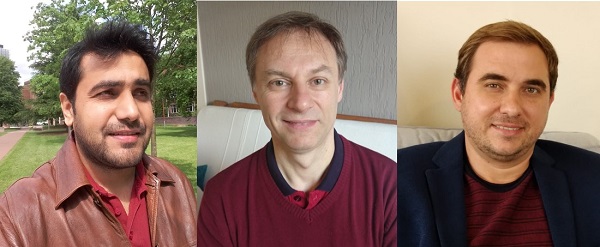
The study received financial support from Brazilian agencies CAPES (including through the CAPES-CNPEM agreement), FAPESP and CNPq (including through INCT-Inomat); from the Brazilian Ministry of Science, Technology, Innovations and Communications (MCTIC) through SisNANO, and The World Academy of Sciences for advancement of science in developing countries (TWAS). The study also received financial support from the Brazil-China Nanotechnology Research and Innovation Center (CBC-Nano).
Applications: biotechnology, health and the environment
According to Martínez, the nanoplatform developed opens perspectives for applications in biotechnology, health and the environment, such as biological tissue and cell imaging systems, medical diagnostic kits, and environmental systems for pollutant detection and remediation
The applications would take advantage of the interesting set of nanoplatform properties. Because they are magnetic, using an external magnet, nanoplatforms could be directed and retained in a particular biological tissue or isolated from, for example, contaminated blood or water. In addition, the luminescence of the nanomaterial would allow visualizing the nanoplatforms within the biological tissues and cells of interest. Finally, the presence of chitosan would enable the chemical binding of drugs and other molecules that would serve for the diagnosis and/or treatment of diseases. “However, much study is still needed for real applications and commercialization of this nanoplatform, as it is a new material and needs to be tested on different models in the future,” says Martinez Martinez.
[Paper: Fe3O4@SiO2 Nanoparticles Concurrently Coated with Chitosan and GdOF:Ce3+,Tb3+ Luminophore for Bioimaging: Toxicity Evaluation in the Zebrafish Model. Latif U. Khan, Gabriela H. da Silva, Aline M. Z. de Medeiros, Zahid U. Khan, Magnus Gidlund, Hermi F. Brito, Oscar Moscoso-Londoño, Diego Muraca, Marcelo Knobel, Carlos A. Pérez, Diego Stéfani T. Martinez. ACS Appl. Nano Mater. 2019, 2,6, 3414-3425. https://doi.org/10.1021/acsanm.9b00339.]

As if she were an architect of the nanoscale, Prof. Julia R. Greer, together with her research group at Caltech (California Institute of Technology) creates three-dimensional structures based on innovatively engineered nanomaterials. The result are metamaterials (artificial materials in which properties depend not only on chemical composition but also on the specific arrangements of nano-sized components into an architected structure) with superior properties. For example, structures with simultaneous extreme lightness and strength or thermal conductivity. Professor Greer and her group develop methods to create such 3D nano-architected materials using an approach called additive manufacturing, and to understand how these properties are generated as a result of multi-scale interactions: atomic, nano and micro scales.
Julia Rosolovsky Greer was born in Moscow (Russia). She began her musical education at the age of 6 and started attending the renowned Gnessin School of Music in Moscow in 5th grade; concurrently in 7th grade she transferred to a Math high school, which in a way served as a foreshadow of her “double-career” as a scientist and a pianist. At 16, she moved with her family to the United States, where she studied and works in three of the top five universities in the world according to the rankings available. For her undergraduate studies she attended the Massachusetts Institute of Technology (MIT), where she obtained in 1997 her major in Chemical Engineering and a minor in Advanced Music Performance. After that, Greer was accepted at Stanford University to undertake graduate studies in Materials Science and Engineering. In 2000, she obtained a M.S. degree, but was discouraged by her at-the-time-supervisor to follow a scientific career. After working for a few years at Intel, Greer decided to return to Stanford to get a Ph.D. Working under the guidance of materials scientist Prof. William D. Nix, who she considers an incredible mentor, Julia made a seminal contribution to nanomechanics and obtained her Ph.D. degree in 2005. After that, she was a postdoctoral fellow at PARC until she joined the faculty of Caltech in 2007, where she is currently a Ruben F. and Donna Mettler Professor of Materials Science, Mechanics, and Medical Engineering.
Professor Greer has an h-index of 56 and over 13,000 citations, according to Google Scholar. She has received a couple of dozen distinctions from scientific institutions, journals and media, and has given more than 100 invited lectures, including named lectures, at scientific events, universities, World Economic Forums and TEDx events. Greer serves as an associate editor for Nano Letters and Extreme Mechanics Letters.
This scientist and concert pianist will be in September in Balneário Camboriú (Brazil), giving a plenary lecture at the XVIII B-MRS Meeting.
See our mini interview with Professor Julia Greer.
B-MRS Newsletter: – In your PhD research, you developed an innovative method to measure mechanical properties of materials at the nanoscale and with it you have made an amazing discovery, right? We would like you to tell us, as briefly as possible, the history of this work, its results and its impact.
When I first arrived at Stanford to start my Ph.D. research with the amazing mentor, Professor W.D. Nix, he vaguely suggested that I should learn how to make small things to test mechanically and see if I could figured out how to use the new-at-the-time instrument, the Focused Ion Beam (FIB). Having worked at Intel for a couple of years, I had learned to do what the Boss tells you to do, so I had learned a very new at the time technique that carves nano-sized shapes by etching the parent material with Ga+ ions. Soon, I had become quite proficient at making nano-cylinders, whose diameters ranged from 1/10,000th of your hair diameter to something like half a thickness of a sheet of paper. I then figured out how to compress them using an instrument called nanoindenter to assess their strength and modulus, and we discovered that as we made those pillars smaller, i.e. reducing the diameter from several microns to a few hundred nanometers, resulted in much higher stresses, i.e. they were able to exhibit much greater strengths. I spent the rest of my 3-year Ph.D. trying to figure out how and why that happened. Together with Prof. Nix, we stumbled upon a pretty impactful finding that smaller was, in fact, stronger, because of the specific behavior and interactions of defects called dislocations within very small, nano- and micro-sized volumes. We did all this work on single crystals of gold, i.e. a relatively malleable metal at the macroscale, whose properties are well understood. When its dimensions were reduced to ~200 nm, it became as strong as steel, exhibiting compressive (and we showed later, tensile, too) stresses close to 800 MPa or even higher; for comparison, the bulk strength of gold is roughly 25 MPa, so it’s 50 times higher! Since then many other research groups have confirmed this type of size effect in many different metals, using different experimental and computational techniques and materials, so it had turned out to be not only a reproducible but seemingly ubiquitous size effect in many different material systems. It has significant implications for how to properly understand material behavior at the nano- and microscale.
B-MRS Newsletter: – In your plenary talk at the B-MRS Meeting, you will talk about three-dimensional nano-architected meta-materials. Could you please choose one of your favorite metamaterials, briefly describe how it is made and mention its (possible) applications?
Well, our meta-materials are like children, I don’t really have a favorite one. What I will do is describe how we usually make these materials, what are their solid constituents – they are all so different: metals, semiconductors, polymers, carbon, ceramics, etc. – and what kind of properties they exhibit. I will describe quite a bit of chemical synthesis, mechanical properties, and show (hopefully 😉 ) interesting visual examples of their response to various stimuli. I am looking forward to the conference!
For more information on this speaker and the plenary talk she will deliver at the XVIII B-MRS Meeting, click on the speaker’s photo and the title of the lecture here https://www.sbpmat.org.br/18encontro/#lectures.
 In July 2019, Innoma is about to make the first sale of its first product, a nanotechnological input with antimicrobial properties that can enable innovations in the cosmetics, textile, paint, packaging and many other industries.
In July 2019, Innoma is about to make the first sale of its first product, a nanotechnological input with antimicrobial properties that can enable innovations in the cosmetics, textile, paint, packaging and many other industries.
The origin of the startup dates back to 2015. At that time, Tiago Hilário Ferreira was a postdoctoral fellow who had accumulated more than 10 years of academic life in Minas Gerais state (Brazil), as well as an entrepreneurial experience of three years as a pizzeria owner. After studying Pharmacy, he had undertaken a master’s and a doctorate in materials science, during which he had researched the production and properties of nanometer-diameter cylinders composed of nitrogen and boron atoms, the boron nitride nanotubes. Finally, as a postdoctoral fellow he used this material to develop a system that could find tumors in the body and fight them efficiently.
In 2015, that postdoctoral work was selected within a program of Minas Gerais government to be presented at an exhibition aimed at communicating to society in general the relationship between science “made in Minas Gerais” and the life of citizens. “At this time, I began to understand the need to bring scientific knowledge closer to society,” says Tiago. “I could really identify with this and based on that first contact I started to look for initiatives in this direction.” A little over a year later, in early 2017, Tiago created Innoma with materials engineer Diego Santos de Oliveira, who was pursuing his master’s degree with research on nanomaterials for health applications.
The initial impulse to create the startup, says Tiago, was the possibility of participating in two programs supporting the emergence and development of startups. Innoma was selected by both programs in 2017 for initial training called pre-acceleration. Initially, the partners’ idea was to produce, on an industrial scale, boron nitride nanoparticles for scientific research and for use in cancer therapies.
However, at the end of the pre-acceleration, the partners realized that they should prioritize projects with greater commercial viability, and opted for silver nanoparticles. These high-efficiency antimicrobials, which can be incorporated into many products, currently have the largest market in the world among nanomaterials, according to data reported by Innoma.
To develop the most suitable technology for nanoactive production, the partners relied on the knowledge acquired during their academic training and entered into a partnership with an university to use physical chemistry laboratories. The generated product was an aqueous dispersion of silver nanoparticles that, according to Tiago, stands out for its great stability and high concentration of the active.
After protecting the chemical route through filed patents, the startup outsourced the industrial production of the product. Thus, Innoma, which until now has been working with its own capital and with an internal team consisting only of the two founding partners, guarantees low operating costs and high production capacity. “We have partnered with a major chemical industry that has all the required certificates and registrations, as well as operational and technological structures capable of meeting the most stringent quality standards,” explains Tiago.
Currently, while marketing its first product, Innoma is working on upcoming releases: copper, zinc and gold based products that promise to benefit diverse segments of the Brazilian industry.
See our interview with Tiago Hilário Ferreira, the executive director at Innoma.
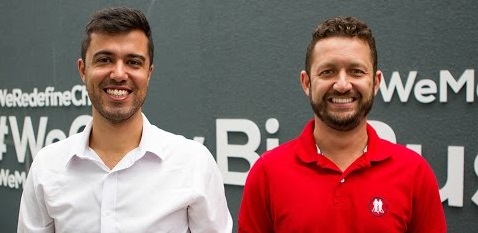
B-MRS Newsletter: What were the most important factors that enabled the creation and development of the startup?
Tiago Hilário: The learning acquired during the pre-acceleration process was very important for the beginning of the business model. Validations with potential customers have driven our efforts. The initial operation with the lowest possible fixed cost enabled our company to remain active during this pre-billing period.
B-MRS Newsletter: What were the main difficulties the startup has faced thus far?
Tiago Hilário: When starting a business from scratch, the difficulties are on a daily basis, the famous “kill one lion a day”. To date, the product development process and market suitability have been the most complicated steps.
B-MRS Newsletter: What do you think is the main contribution of the startup to society?
Tiago Hilário: We work to supply high efficiency nanocompounds to the domestic market, making it possible to use these materials in new products that until then had no commercial viability.
By doing this, and in accordance with the Brazilian government guidelines, we expect to promote increased human performance, its processes and products, quality of life and social justice.
B-MRS Newsletter: What is your goal/dream for the startup?
Tiago Hilário: The goal is for Innoma to establish itself as a company later this year, so that the partners can dedicate fully to the startup. Our dream is to be a national reference in this market.
B-MRS Newsletter: Leave a message for our newsletter readers and social media followers who are considering creating a startup.
Tiago Hilário: I have three tips for those who want to create a startup:
–The process is slow. It usually takes longer than expected and you need to be prepared for it.
– Too much money as well as too little money gets in the way. With a lot of resources, partners tend to run over validations and make wrong investments. With too little, the project becomes unachievable.
– The team is the most important. We tend to believe that the idea is the main thing, but a strong and motivated team is the factor that makes the biggest difference in the success of a startup.
The directory and board of the Brazilian Materials Research Society (B-MRS) are in solidarity with the Director of the Brazilian National Institute for Space Research (INPE), Prof. Ricardo Magnus Osório Galvão, with regard to the unsubstantiated claims by President Jair Bolsonaro. Had the President been careful to verify INPE’s work and Professor Ricardo Galvão contributions, he would not have made such an unfounded accusation.
Public agencies and their officials must serve the people and the Nation and are therefore subject to criticism and evaluation. However, it is inadmissible for a President of the Republic to make public accusations without the bare minimum of verification. It’s not just Professor Ricardo Galvão and INPE that the President offends, but all who work in favor of Brazil for knowledge generation.
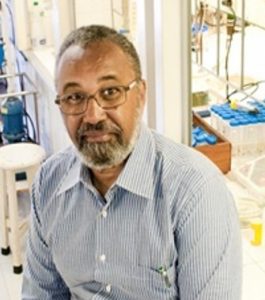
Professor Oswaldo Luiz Alves (IQ – Unicamp), a B-MRS member, is one of the corresponding authors of an article selected to compose a thematic collection of the Royal Society of Chemistry (RSC), commemorating the International Year of the Periodic Table. The collection, which can be accessed here, brings together 55 papers on low carbon dimensional systems and their applications, published between 2017 and 2019 in some RSC journals.
The paper signed by Professor Alves with seven other researchers from Brazil reports the toxicity and nanobiointeractions of a functionalized graphene oxide with respect to human blood components. The article was originally published in 2018 in the Journal of Materials Chemistry B and has just been featured in the commemorative collection, which is available in open access mode.
Article reference: Marcelo de Sousa, Carlos H. Z. Martins, Lidiane S. Franqui, Leandro C. Fonseca, Fabrício S. Delite, Evandro M. Lanzoni, Diego Stéfani T. Martinez and Oswaldo L. Alves. Covalent functionalization of graphene oxide with D-mannose: evaluating the hemolytic effect and protein corona formation. J. Mater. Chem. B, 2018,6, 2803-2812. DOI:10.1039/C7TB02997G. Available at: https://pubs.rsc.org/en/content/articlehtml/2018/tb/c7tb02997g?page=search (HTML)
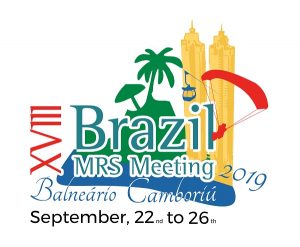 Online registration for the XVIII B-MRS Meeting (Balneário Camboriú, September 22 to 26, 2019) is open.
Online registration for the XVIII B-MRS Meeting (Balneário Camboriú, September 22 to 26, 2019) is open.
Early registration (with descount) is open by August 2 August 9. Onsite registration at the event venue (Hotel Sibara) will be available throughout the meeting.
For participants of Brazilian institutions, B-MRS members benefit from additional discounts, and it is possible to become a B-MRS member or renew membership at the moment of meeting registration (online or onsite).
All registration fees are available on the meeting website: https://www.sbpmat.org.br/
|
|||||||||||||||||||||
|
|||||||||||||||||||||
|

When he answered the telephone on that May afternoon, Leonardo Mathias Leidens, 24 years old, thought it was a hoax. The president of CNPq (the Brazilian federal organization dedicated to the promotion of science and technology) was giving him the news that his undergraduate research (iniciação científica in Portuguese) had been chosen as the best in Brazil in the area of Exact, Earth and Engineering Sciences, in the sixteenth edition of the Prêmio Destaque na Iniciação Científica e Tecnológica.
However, in hindsight, if Leonardo had contained his excitement and looked back at that moment, he would have realized that the prize was in fact a likely consequence of a steady path through scientific knowledge, and a well-deserved recognition of his competency and dedication.
Leonardo was born in 1995 in Caxias do Sul, municipality of the Brazilian State of Rio Grande do Sul, of about 500 thousand inhabitants and an important industrial pole. After attending a public school in the city, always with excellent school performance, in 2013 Leonardo joined the undergraduate course in Chemical Engineering of the University of Caxias do Sul (UCS), a community university headquartered in Caxias do Sul, which has its campi in eight municipalities of the region.
In the first half of 2014, Leonardo found an opportunity to start doing science. He became a scientific initiation fellow, under the guidance of Professor Carlos A. Figueroa, leader in the UCS of a group of fundamental and applied research in Surface Science and Engineering, which would later receive the name of “Epipolé Group.” In this group, and always with the same advisor, Leonardo worked in several studies concerning the adhesion of amorphous carbon films as a scholarship holder of the university and then of the CNPq programs for undergraduate research. As a result of this work, Leonardo has today nine scientific papers (one of them as first author) published in international peer-reviewed journals, including some of the best journals in the area of surfaces and thin film.
In August 2016, Leonardo left the country for the first time to attend two semesters at the École Supérieure des Industries Chimiques (ENSIC), in the city of Nancy (France), after being selected as a fellow of BRAFITEC, a Brazilian federal program that supports the mobility of engineering students between institutions in Brazil and France. In this period, in addition to attend the courses, Leonardo presented, for the first time, a work in an international scientific event, the E-MRS 2017 Spring Meeting, held in the French city of Strasbourg.
After this enriching experience abroad, in mid-2017, Leonardo returned to Caxias do Sul and resumed his academic activities at UCS, including the undergraduate research in the Epipolé Group. In December 2018, he completed his bachelor’s degree in Chemical Engineering with a 3.96 average out of a maximum of 4 in all of the subjects studied. As a result, on graduation day, Leonardo was awarded the Academic Laurel by the Rector of UCS.
Due to his experience in more than four years as an undergraduate research fellow, Leonardo decided to pursue a doctorate without undertaking masters studies (Masters degree is the usual step before PhD in Brazil). Thus, earlier this year, he became a doctoral candidate of the Postgraduate Program in Materials Engineering and Science (PGMAT) of UCS, again under the guidance of Professor Figueroa.
On July 23, Leonardo will receive his CNPq award at the ceremony to be held in the city of Campo Grande (State of Mato Grosso do Sul) during the 71st Annual Meeting of the Brazilian Society for the Progress of Science (SBPC).
See our interview with Leonardo.
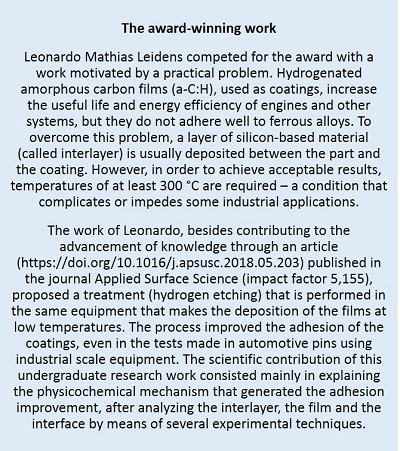 B-MRS Bulletin: Could you tell us briefly how and when you started and developed your interest in science/research? And your desire to become a scientist?
B-MRS Bulletin: Could you tell us briefly how and when you started and developed your interest in science/research? And your desire to become a scientist?
Leonardo Mathias Leidens: Curiosity has always been a perceivable characteristic of my personality. The will and concern to know the origin of “everything”, the whys and how things work led me to science, even if in a somewhat unconscious way. My parents always encouraged me to read and this was essential in the search for answers to my questions and in the development of creativity. More than that, as a child, I loved to work on simple experiments I learned on TV shows (unfortunately, the internet was not widely available in the 90s) or to create my own awkward experiments when I got a children’s chemistry kit (but with the simple instructions I would soon lose interest). Curiously, it took me quite a while to realize that combining all these things I did naturally and enjoyably could shape my career. It took a few years until, in high school, the penny dropped, and from there on I set out to achieve a new goal: to become a scientist. I entered the Chemical Engineering course with the intention of participating in Undergraduate Research activities and follow the academic career.
B-MRS Bulletin: Very briefly, what were the main competencies you have developed over the years as an undergraduate research fellow?
Leonardo Mathias Leidens: Basically, the greatest personal and professional development was the training in the “scientific method,” that is, the initial competency for training a scientist. Asking questions, seeking the state of the art and the answers already available for comparison with the presented reality and questioning/comparing the results became daily activities. In order to be able to develop all these research steps, training in complex equipment, data analysis and the proposal of ideas and projects were skills that I had to developed. In addition, throughout my scholarship I was able to improve languages, such as English (the language of science), as well as writing papers more meticulously and aptly for international journals, congresses, reports and projects.
B-MRS Bulletin: In your view, what were the most important factors that contributed to the achievement of the award-winning work?
Leonardo Mathias Leidens: Initially, it was the group’s trajectory, structure and experience in different approaches to minimize the adhesion problem of amorphous carbon films in ferrous alloys that allowed the work proposal and the result achieved, because with broad knowledge of the material system studied, it was possible to investigate in a meaningful way the problem and the positive modifications generated with the use of the hydrogen plasma. In my view, the success was the integration of basic science (the study of physicochemical mechanism of the treatment) with a real problem (to deposit the coatings under milder and efficient conditions on previously problematic substrates), which made the work complete and interesting in the scientific (knowledge generation) and industrial (applications with energy efficiency appeal) scopes.
B-MRS Bulletin: In another interview, you talk about being a scientist as a lifestyle, not just a profession. Tell us about that lifestyle that attracts you.
Leonardo Mathias Leidens: That expression has, fundamentally, two justifications. First, and as I said earlier, the scientific method was one of the most important learning aspects I have experienced over the years. It is applied not only in research but in various activities. Questioning and verifying everything (by tests and comparisons) are a scientist’s requirement, both inside and outside the laboratory. For example, in a society where never-ending information (of different qualities) is available, rigor becomes necessary to compare, select, and verify just how true or secure the sources are. On the other hand, science as a way of life means living science broadly. Integrating a diverse community, participating in projects and partnerships, and being able to make a difference in any area (no matter how small it looks) is much more than a profession. Finally, being part of a group of people who, with different backgrounds, stories and goals, come together and work for the generation of knowledge and advancement of humanity, even with so many difficulties, attracts me, encourages me and is a source of pride.
B-MRS Bulletin: You are currently in the first year of your doctorate. Have you thought about any project or career path after your PhD?
Leonardo Mathias Leidens: My advisor always suggests planning the next five years (at least)… It’s not always easy, especially in very unstable times. Regarding the doctorate, I would like to participate in a sandwich period at a university abroad because, having lived through this experience during my undergraduate studies, I realize the greater importance it would have in my scientific training as a doctor. Later, I intend to follow in the academic career, as researcher, in some institution here in Brazil or abroad.
B-MRS Bulletin: We invite you to leave some tips for our readers who are carrying out scientific initiation work in the area of Materials, answering the question “How to develop a national outstanding work.”
Leonardo Mathias Leidens: It’s not easy to directly suggest ways to produce a distinguished work because, to a certain extent, this is a consequence of a job well done and not the result of a “formula.” However, to reach the goal, I can say that one must take an active role in the research, proposing, without fear or apprehension, well-founded ideas for a problem of the area, even if at the beginning it is difficult and challenging for a undergraduate student. As we produce our own questions, we are encouraged to seek the answers and if they are not available, offer ways to obtain them Thus, with lots of work, dedication and scientific discussion, it is possible to transform a project into an outstanding work that can contribute to the advancement of a specific area and, more extensively, of society. However, one thing is fundamental: do not get absolutely discouraged when things do not go as planned. When we are on the frontier of knowledge, the result is not always the expected result – but this cannot curb the advance for further attempts.
With regards to me, as an undergraduate researcher in the Epipolé Group, I have always had the opportunity to participate actively in projects and discussions (and not only follow graduate students or do “mechanical” work, although these activities are also part of any undergraduate research grant and are important), even as a student of the initial undergraduate periods, and I enjoyed all these moments. This was instrumental in understanding how science is made and integrate with the group. Although greater responsibilities are created in these interactions, they were instrumental in the growth, encouragement and formation of a basis that allowed me to propose my own ideas, after a period of study and practice. For this, reading many scientific articles was also fundamental, besides being always abreast of the innovations of the area, but not forgetting to pay due attention to the scientific foundations, that is, the fundamental concepts.
[Paper: Graphene on the oxidized SiC surface and the impact of the metal intercalation. J.E.Padilha, R.B.Pontes, F. Crasto de Lima, R. Kagimura, R. H. Miwa. Carbon, Volume 145, April 2019, Pages 603-613.]
Controlling the electronic properties of graphene on silicon carbide
A Brazilian scientific team performed a study based on supercomputer simulations that reveals a way to overcome the challenge of controlling the electronic properties of graphene. Solutions to this challenge can make a difference in the development of two-dimensional electronic devices – a dimension in which graphene, the one-atom thick network of carbon atoms, stands out for its properties.
In fact, graphene is an extremely tough, lightweight, flexible and transparent material. It is also an excellent conductor of heat and electricity. However, it is still difficult to control the concentration and flow of electric charges in graphene, which limits its use in electronics.
Solutions have been proposed to overcome this technological limitation of graphene. Some of them are based on the insertion of small amounts of metallic atoms that modulate the electronic properties of the material without impairing the other characteristics. The method is similar to the doping of silicon, practiced routinely in the manufacture of semiconductors for the electronics industry.
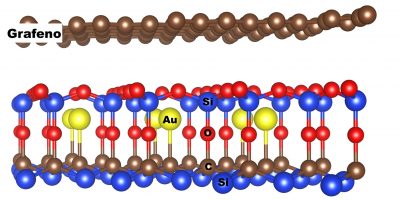
In the study that was recently reported in the scientific journal Carbon (impact factor 7,466), the Brazilian team investigated the structure and electronic properties of a graphene sheet on a silicon carbide (SiC) substrate – material often used to deposit or grow graphene. In this system, graphene remains attached to the substrate without chemical bonds, by means of distance-dependent weak attraction forces, called Van der Waals forces.
Given that in the production of graphene the presence of oxygen usually oxidizes the surface of the silicon carbide, the Brazilian scientists included in the simulations a layer of silicon oxide between the graphene and the substrate. Finally, in order to understand in detail the effect of the insertion of metallic atoms into this type of materials, the scientists added to the simulated system a layer of gold or aluminum atoms embedded in the oxide layer (in this case, Si2O5) in the interface region with graphene.
The researchers verified that the presence of the metallic layer modulates the concentration of the positive (so-called holes) and negative (the electrons) charge carriers in both the graphene sheet and Si2O5. In addition, the gold and aluminum atoms embedded in the Si2O5, which is semiconductor, induce the formation of conducting regions on the surface of this layer, in which the excess of electrons or holes is concentrated, induced by the presence of gold or aluminum, respectively. As a result, conductive channels are formed on the surface of the Si2O5, through which the charges flow.
![This two-dimensional map series shows the concentrations of electrons and holes in the graphene sheet in the two graphene systems on the silicon carbide surface finished in Si [(a) and (c)] and terminated in C [(b) and ( d)]; in the presence of an aluminum monolayer [(a) and (b)] and the other containing a gold layer [(c) and (d)].](https://www.sbpmat.org.br/site/wp-content/uploads/2019/06/dopagem-grafeno.jpg)
Based on these evidences, which were obtained mainly through computational simulations based on the Density Functional Theory, the paper suggests a way to control the concentration and flow of electrical charges on graphene sheets on silicon carbide substrates. The study also shows that the system studied (graphene sheet on oxidized silicon carbide with intercalated metal layer) can be a good platform for engineering electronic properties.
“The main contribution of the study is to show an efficient way of controlling the electronic properties of graphene on a solid surface covered with a metallic layer, by applying an external electric field,” says Professor Roberto Hiroki Miwa (Federal University of Uberlândia, UFU ), corresponding author of the paper. “We show that in addition to controlling the doping level of graphene, which is fundamental for the development of electronic devices in two-dimensional (2D) systems, the presence of the metallic monolayer allows the formation of conducting channels on the surface of the silicon carbide,” he adds. According to Miwa, the study may contribute to the development of faster, more accurate sensors, transistors and other electronic devices for charge transport and signal delivery.
At the beginning the work was motivated by the interest of UFU professors Roberto Hiroki Miwa and Ricardo Kagimura in understanding the graphene/oxide interfaces at the atomic level. The focus of the study matured as the authors delved into the scientific literature. As the volume and complexity of calculations increased, the researchers included new collaborators: a physics doctoral student at UFU (Felipe David Crasto de Lima) and professors from other institutions (José Eduardo Padilha de Sousa, from the Federal University of Paraná – Jandaia do Sul campus, and Renato Borges Pontes, Federal University of Goiás).

In order to perform the calculations that support the simulations, the authors used computational resources from the Brazilian National Center for High Performance Processing (CENAPD) and the SDumont supercomputer of the Brazilian National Laboratory of Scientific Computation (LNCC). The work was funded by federal agencies CNPq and CAPES and the state agency FAPEMIG (Minas Gerais).